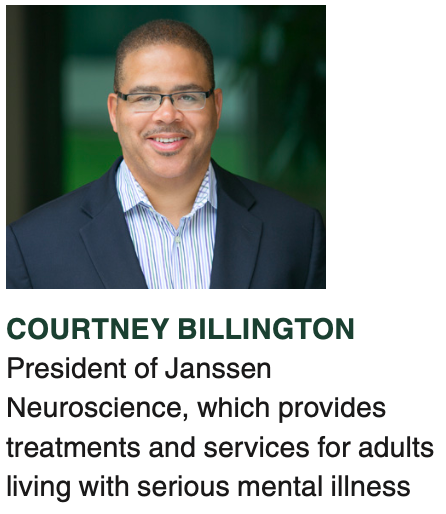Restoring Hope in Mental Illness Is a Collective Mission
The importance of equitable approaches to diagnosis and treatment.

Our mental health system is complex, often leading to disruptions in care that can have significant consequences for those who are most in need. Serious mental illness lacks the level of parity, investment, and social acceptance that other disease states have, which means some of the most vulnerable patients are unable to access the care they need.
Disparities in care
Mental illness can affect anyone regardless of gender, income, race, ethnicity, or other aspects of identity.1 More than half (57%) of US adults with any mental illness don’t receive treatment, and this unmet need is even greater for communities of color.2,3 Looking at the environment for people of color, disparities persist at every turn—from lower levels of mental health diagnosis to lack of culturally appropriate care and available care settings. These factors, combined with social determinants of health, contribute to systemic healthcare inequities and are present in the Black community in particular.2,4
Only one in three Black adults in the US who need mental health care receives it, even though rates of mental illness are similar among Black, Hispanic, and white adults.5,6 Black adults living with mental illness disproportionately receive treatment in emergency and hospital settings and are at a higher risk of incarceration.7,8,9
The stigma surrounding mental illness, and prejudices that Black people in the US face, can impact help-seeking behaviors.10 When Black adults do receive treatment, it’s often poorer quality care.2
Solutions are needed at every level
Historical racism and sociocultural factors must be addressed to improve disparities. Three areas of greatest need are education and awareness, economic empowerment, and greater equity in care. Improving diversity and representation in the mental health workforce supports these needs. Cultural competence and culturally responsive services can boost engagement and retention in mental health treatment.11 Yet, only 2% of psychiatrists identify as Black.12
Implementing equitable approaches to mental health assessment and comprehensive treatment must be prioritized in all sectors and care settings. To combat disparities, we need to galvanize efforts across the country and healthcare industry.
Hope through partnership
As a Black professional, leader in healthcare, and someone who saw firsthand the stigma associated with family mental illness, I’m driven by the opportunity to restore hope for adults living with serious mental health conditions. At Janssen Neuroscience, I’m surrounded by colleagues equally committed to going the extra mile for patients in need. We constantly seek like-minded partners who want to make a difference in mental illness and for communities facing the highest degree of disparities. As part of this commitment, we’ve established the Community Health Equity Alliance, where we collaborate with local advocacy, civic, faith-based, and healthcare professional organizations, academia, and others to enact change and help achieve more equitable mental healthcare for Black Americans.
There’s more progress to be made—that will always be the case. Each of us must do our part.
Courtney Billington, President of Janssen Neuroscience, which provides treatments and services for adults living with serious mental illness
References
- American Psychiatric Association. What is Mental Illness. 2021. https://www.psychiatry.org/patients-families/what-is-mental-illness
- Agency for Healthcare Research and Quality. 2019 National Healthcare Quality & Disparities Report. https://www.ahrq.gov/sites/default/files/wysiwyg/research/findings/nhqrdr/2019qdr.pdf
- Mental Health America. 2021 The State of Mental Health in America. https://mhanational.org/issues/2021/mental-health-america-all-data
- Mental Health: Culture, Race, and Ethnicity: A Supplement to Mental Health: A Report of the Surgeon General. Rockville (MD): Substance Abuse and Mental Health Services Administration; August 2001. https://www.ncbi.nlm.nih.gov/books/NBK44243/
- National Institute of Mental Health. Mental Health Statistics. https://www.nimh.nih.gov/health/statistics/mental-illness
- Substance Abuse and Mental Health Services Administration. Racial/Ethnic Differences in Mental Health Service Use among Adults. 2015.
- Hawthorne W, et al. Incarceration among adults who are in the public mental health system: rates, risk factors, and short-term outcomes. Psychiatr Serv. 2012;63(1):26-32.
- Snowden LR, Catalano R, Shumway M. Disproportionate use of psychiatric emergency services by African Americans. Psychiatr Serv. 2009;60(12):1664-1671.
- Working with African American/Black Patients. American Psychiatric Association. https://www.psychiatry.org/psychiatrists/cultural-competency/education/best-practice-highlights/best-practice-highlights-for-working-with-african-american-patients
- Centers for Disease Control and Prevention. Nov. 30, 2021. Health Equity Considerations and Racial and Ethnic Minority Groups. https://www.cdc.gov/coronavirus/2019-ncov/community/health-equity/race-ethnicity.html
- Substance Abuse and Mental Health Services Administration. Improving Cultural Competence. Treatment Improvement Protocol (TIP) Series No.59. 2014.
- American Psychological Association. (2017). Demographic characteristics of APA members by membership characteristics. https://www.apa.org/workforce/publications/17-member-profiles/table-1.pdf
